
N = R x Fp x Ne x Fl x Fi x Fc x L
where
| Home Page | Overview | Site Map | Index | Appendix | Illustration | Preface | Contact | Update | FAQ |
 |
In order to communicate with the other worlds, it requires that both sides should be highly evolved to an advanced technological stage. In 1961, Frank Drake (Figure 09-19a), now President of the SETI (Search for Extra-Terrestrial Intelligence) Institute, proposed a formula for estimating the existence of communicating Intelligent Life elsewhere in our galaxy. This is known as The Drake Equation, which states that N = R x Fp x Ne x Fl x Fi x Fc x L where |
Figure 09-19a Frank Drake |
 8 (
8 ( 400 according to updated data) civilizations within
400 according to updated data) civilizations within
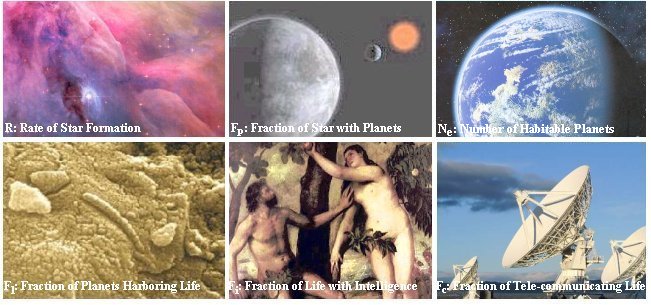 |
 |
the Milky Way that are currently broadcasting detectable signals. These chosen numbers are the lower limits and worse case scenarios. For example, a techno-logical civilization could last for 1000 years or more, dramatically increasing the value of N. Figure 09-19b depicts the parameters of the Drake equation in a pictorial form. The diagram in Figure 09-19c illustrates the stringent requirements in limiting the number of communicating civilization into a small fraction of the number of stars in the Milky Way. |
Figure 09-19b Drake Parameters |
Figure 09-19c Drake Diagram |
 3600. Such number actually involves a lot of uncertainty. But as someone points out: "The Drake Equation's biggest contribution is in framing the discussion rather than providing an absolute answer"
3600. Such number actually involves a lot of uncertainty. But as someone points out: "The Drake Equation's biggest contribution is in framing the discussion rather than providing an absolute answer"
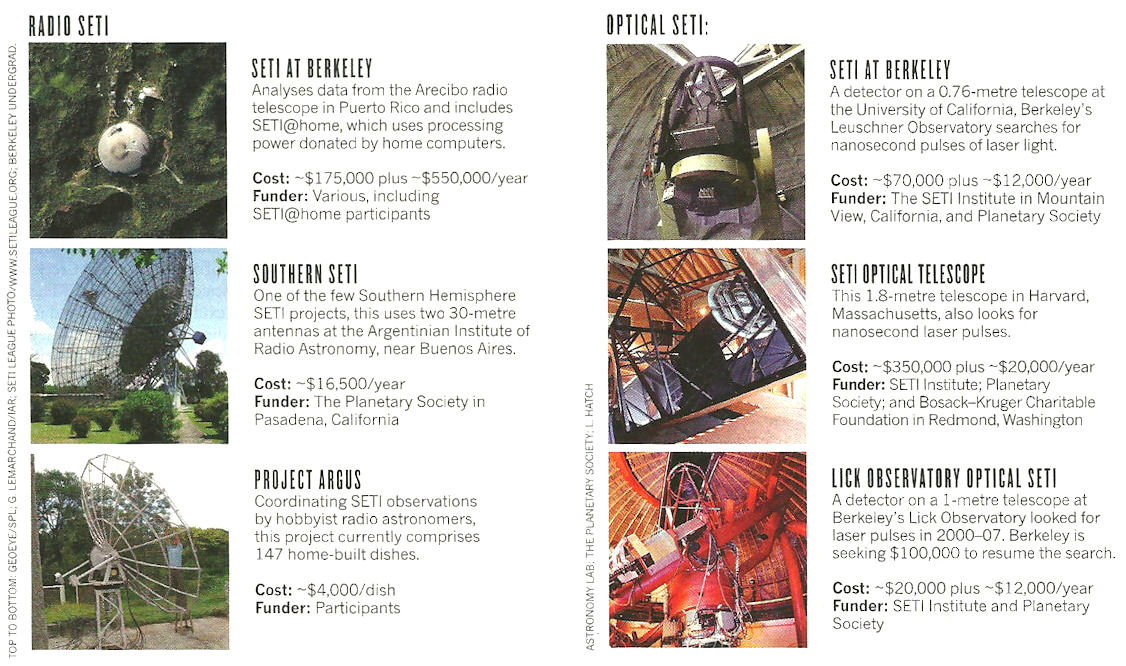 |
Thanks to the 2300 individual donations (including contribution from Jodie Foster of the 1997 movie Contact) for a total of $206,000 in early August 2011, the Allen Telescope Array may be able to hang on to its dear life if the USAF accepts the offer of using the facility to track space debris around the Earth. This is just one facet to reveal a once great power in decline. Other scientific projects such as the JWST (replacement for the HST) are also in danger of cancellation. The "debt ceiling" debacle threatens more cuts in funding things of science. |
Figure 09-19e Small Scale SETI Projects |
 |
In the summer of 2004, a flurry of reports in the media indicate that radio signals (at 1420 megahertz = the hyperfine transition frequency of the hydrogen atom) have been detected three times from a point between the constellations Pisces and Aries. The transmission is very weak and shifting rapidly in frequency. It is pointed out that such drifting of frequency is too rapid to be produced by the rotation of planet and three occasions of detection is not statistically significant. The signals could be generated by a previously unknown astronomical phenomenon, or it could be something much more mundane, maybe an artefact of the telescope itself. |
Figure 09-19f Search for ET |
 |
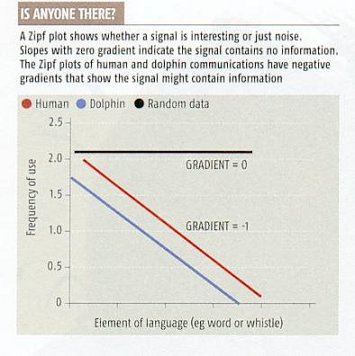 |
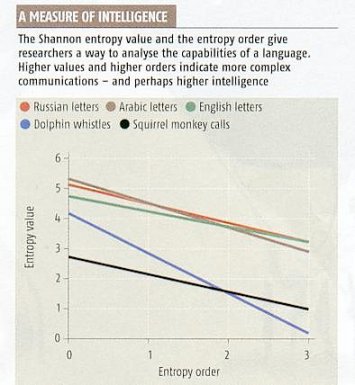 |
positively identified, astronomers have found many attributes characteristic of a more mundane and ultimately terrestrial origin. In this case, a leading possibility is that the signal originates from an unusual modulation between a GPS satellite and an unidentified Earth-based source. Many unusual signals from space remain unidentified. No signal has yet been strong enough or run long |
Figure 09-20 ET Signal | Figure 09-21 Zipf Plot |
Figure 09-22 Entropy Order |
enough to be unambiguously identified as originating from an extraterrestrial intelligence. |
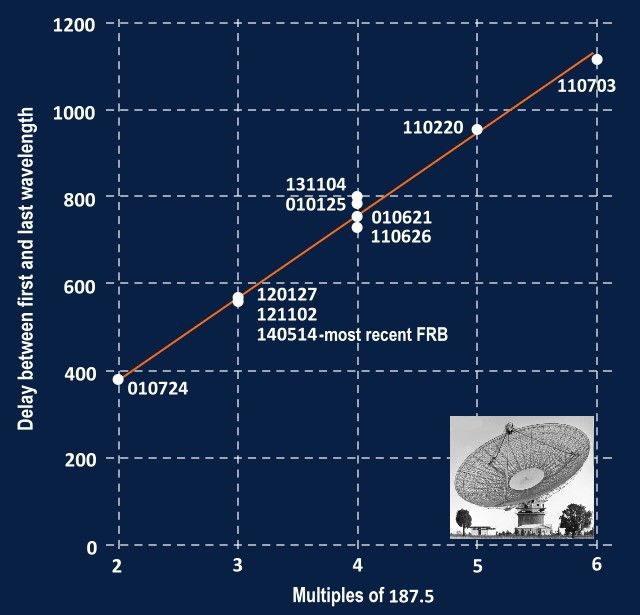 |
There are ten strange signals detected from 2001 to 2014 by the Parkes radio telescope in Australia as reported in a "2015 New Scientist article". The signals are in the form of short duration radio wave lasting for a few milliseconds but with a rather large bandwidth. Components with different wavelength in these radio bursts are spatially separated as they travel through the interstellar medium. The dispersion in wavelength is found to be in an integer multiplication of 187.5 for all the ten measurements (see Figure 09-23a). This is the opposite of ET signaling criterion as shown in Figure 09-20. Nevertheless, these curious signals have generated considerable interests. The short time duration implies that the source cannot be larger then hundreds of kilometers; and the energy output could be enormous depending on the distance of the source from Earth. It could be a new kind of astronomical object, or may involve a new kind of physics, or originated from an unknown human technology. Failing with such kind of explanations, the source could ultimately be attributed to Extra-Terrestrial Intelligence. |
Figure 09-23a Strange Signals [view large image] |
According to the Optical Dispersion formula, these data points are the manifestions of either the spread of wavelength or variation of optical path length in integer steps. |
 |
In all the great oceans of emptiness, stars of type G are the best candidates to look for life - these are stars like the sun. They are of moderate, but comfortable brightness and remain stable for about 10 billion years - sufficient time for complex life forms to evolve. Tau Ceti is such a G-type, sunlike star, devoid of stellar companions and close enough for detailed studies. It was the first object searched for ET radio signals. Though Tau Ceti has about half the sun's luminosity, its habitable zone still comprises about one third AU - this is wide enough that a terran planet may have formed there. But we know from other stars that giant gas planets are common, and they are often very close to their parent star. So if Tau Ceti happens to have a system of planets, a gas giant may orbit within the habitable zone, leaving no space for an additional terrestrial planet. But this giant planet may have moons, possibly of Earth's size, where life may get a start. |
Figure 09-23b Tau Ceti |
Climate on such a large moon of Tau Ceti's giant planet would not be substantially different from our own. Depending on the parent planet's orbital radius, this world might see the whole range of conditions from the greenhouse of the Mesozoic to the great ice ages of the Pleistocene. |

 |
|
Figure 09-24 Pioneers-10 Plaque [view large image] |
in 2 million years. So far no "alien" or "advanced civilization" has yet seen the plaque. The last signal was received on January 22, 2003. |